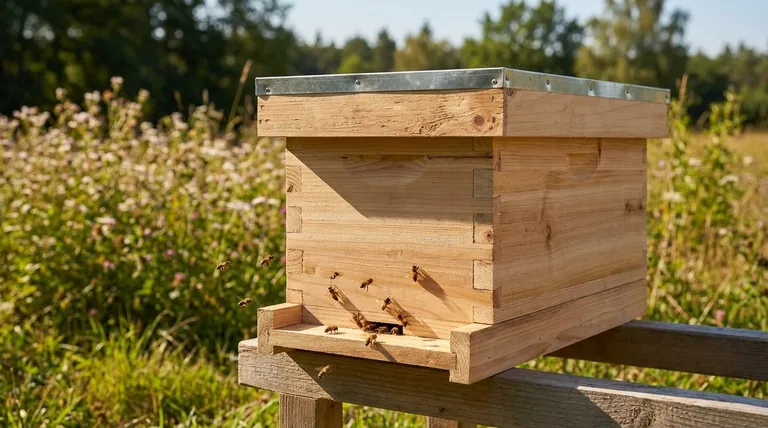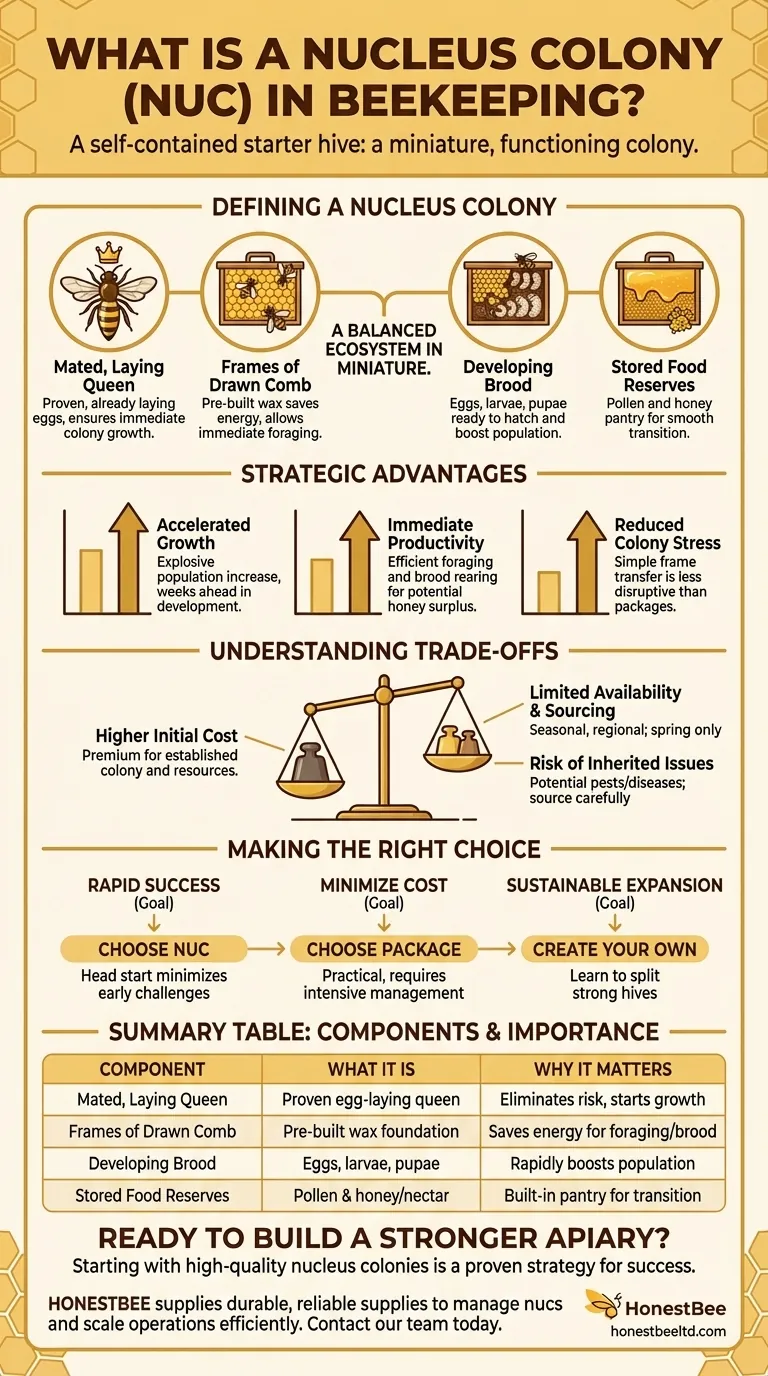In beekeeping, a nucleus colony is a small, self-contained starter hive, often called a "nuc." It is not just a collection of bees; it is a miniature, functioning colony transferred from an established hive. A nuc contains a mated, laying queen, several thousand worker bees, and most importantly, frames of comb containing developing brood, pollen, and honey.
A nucleus colony is best understood as a "plug-and-play" beehive. Unlike a package of loose bees, a nuc provides the bees with a complete, established home and a significant head start, drastically accelerating the new colony's growth and productivity.

What Defines a Nucleus Colony?
A nuc is a balanced ecosystem in miniature. Each component is critical for its immediate survival and rapid expansion into a full-sized production hive.
The Mated, Laying Queen
The heart of the nuc is a proven queen who is already laying eggs. This confirms she has been accepted by the colony and is actively building the workforce, eliminating the uncertainty that can come with introducing a new queen.
Frames of Drawn Comb
A nuc includes several frames (typically four or five) of pre-built wax comb. The bees do not have to expend immense energy and resources to build this foundational structure from scratch.
Developing Brood
These frames contain brood—eggs, larvae, and pupae—in various stages of development. This means a new generation of worker bees is already on the way and will begin hatching within days of installation, rapidly boosting the colony's population.
Stored Food Reserves
The frames also contain stored pollen (protein for feeding young bees) and nectar or honey (carbohydrates for energy). This built-in pantry ensures the colony has the fuel it needs to manage the transition into its new home.
The Strategic Advantage of a Nuc
For beekeepers, especially beginners, starting with a nuc offers distinct advantages that directly impact the success and timeline of establishing a new hive.
Accelerated Growth
Because the queen is already laying and new bees are constantly emerging, a nuc's population explodes much faster than a colony started from a package. They are often weeks ahead in their development cycle.
Immediate Productivity
With the comb already built, the workforce can immediately focus on foraging for nectar and pollen, tending to the queen, and raising more brood. This efficiency often allows a nuc to produce a honey surplus in its first year, a goal that is more challenging for a package.
Reduced Colony Stress
Installing a nuc is a simple process of transferring frames from the nuc box to a standard hive box. This is far less disruptive and stressful for the bees than the process of establishing a colony from a loose package of bees.
Understanding the Trade-offs
While powerful, nucs are not the only option, and it's important to understand their limitations to make an informed decision.
Higher Initial Cost
A nuc is more expensive than a package of bees. You are paying a premium for the established comb, brood, and a proven queen, which represent significant time and resources from the beekeeper who produced it.
Limited Availability and Sourcing
Nucs are typically produced by local beekeepers and are only available in the spring after their own hives have become strong enough to be split. This makes them a regional and seasonal resource that cannot be easily shipped long distances.
Risk of Inherited Issues
Because you are receiving frames from another apiary, there is a small but real risk of inheriting pests (like Varroa mites) or diseases. It is critical to source your nuc from a reputable, trusted beekeeper with a proven track record of hive health.
Making the Right Choice for Your Goal
Your primary objective as a beekeeper will determine whether a nucleus colony or another method is the right starting point.
- If your primary focus is rapid establishment and a higher chance of first-year success: A nuc is the superior choice because its head start minimizes early challenges.
- If your primary focus is minimizing initial cost or you need to source bees from afar: A package of bees is a more practical and accessible option, though it requires more intensive early management.
- If you are an established beekeeper looking to expand sustainably: Learning to create your own nucs from your strongest hives is a fundamental skill for growth and management.
Understanding the nucleus colony empowers you to make strategic decisions that align with your goals and accelerate your journey as a beekeeper.
Summary Table:
| Component | What It Is | Why It Matters |
|---|---|---|
| Mated, Laying Queen | A proven, egg-laying queen | Eliminates introduction risk; colony growth starts immediately. |
| Frames of Drawn Comb | Pre-built wax foundation | Saves bees weeks of energy; they can focus on foraging and brood. |
| Developing Brood | Eggs, larvae, and pupae | New worker bees hatch within days, rapidly boosting population. |
| Stored Food Reserves | Pollen and honey/nectar | Built-in pantry ensures the colony has fuel for a smooth transition. |
Ready to build a stronger, more productive apiary?
Starting with high-quality nucleus colonies is a proven strategy for success. At HONESTBEE, we supply commercial apiaries and beekeeping equipment distributors with the durable, reliable supplies needed to manage nucs and scale operations efficiently. From nuc boxes to full hive systems, our wholesale-focused operations are designed to support your growth.
Contact our team today to discuss your supply needs and how we can help your business thrive.
Visual Guide

Related Products
- 5 Frame Wooden Nuc Box for Beekeeping
- HONESTBEE Professional Long Handled Hive Tool with Precision Cutting Blade
- HONESTBEE Advanced Ergonomic Stainless Steel Hive Tool for Beekeeping
- 5 Frame Langstroth Poly Nuc Corrugated Plastic Nuc Boxes
- HONESTBEE Professional Entrance Bee Feeder Hive Nutrition Solution
People Also Ask
- What is the advantage of overwintering a nucleus? A Strategic Asset for Beekeeping Success
- What are the benefits of moving nuclei around the apiary? Master Strategic Hive Management
- What frames should be moved into the queenless hive when requeening with a nuc? Ensure a Successful Queen Introduction
- How many frames does a typical wooden nuc box hold? A Guide to Choosing the Right Size
- What is the purpose of having a nuc in beekeeping? Build a Resilient & Productive Apiary



















